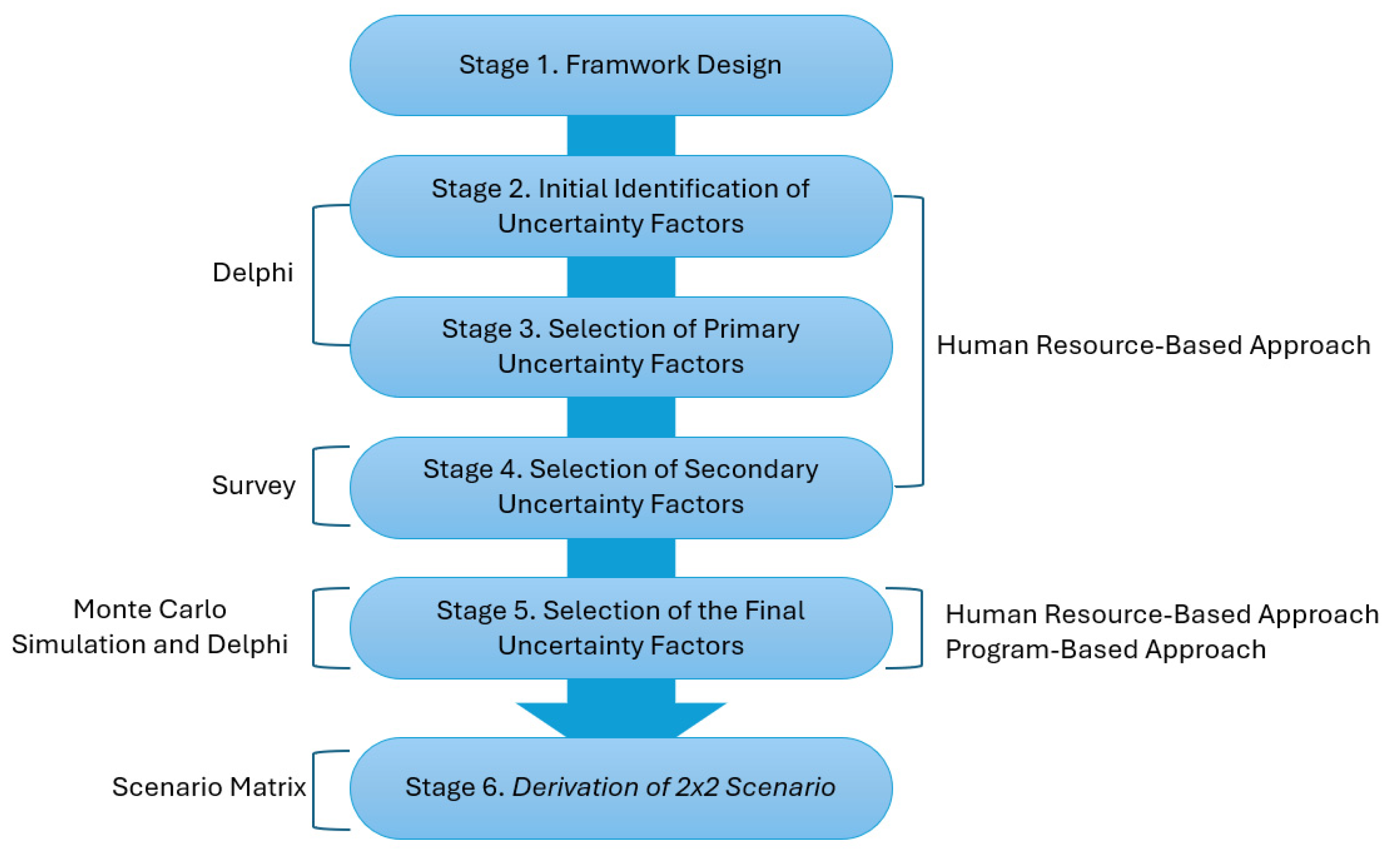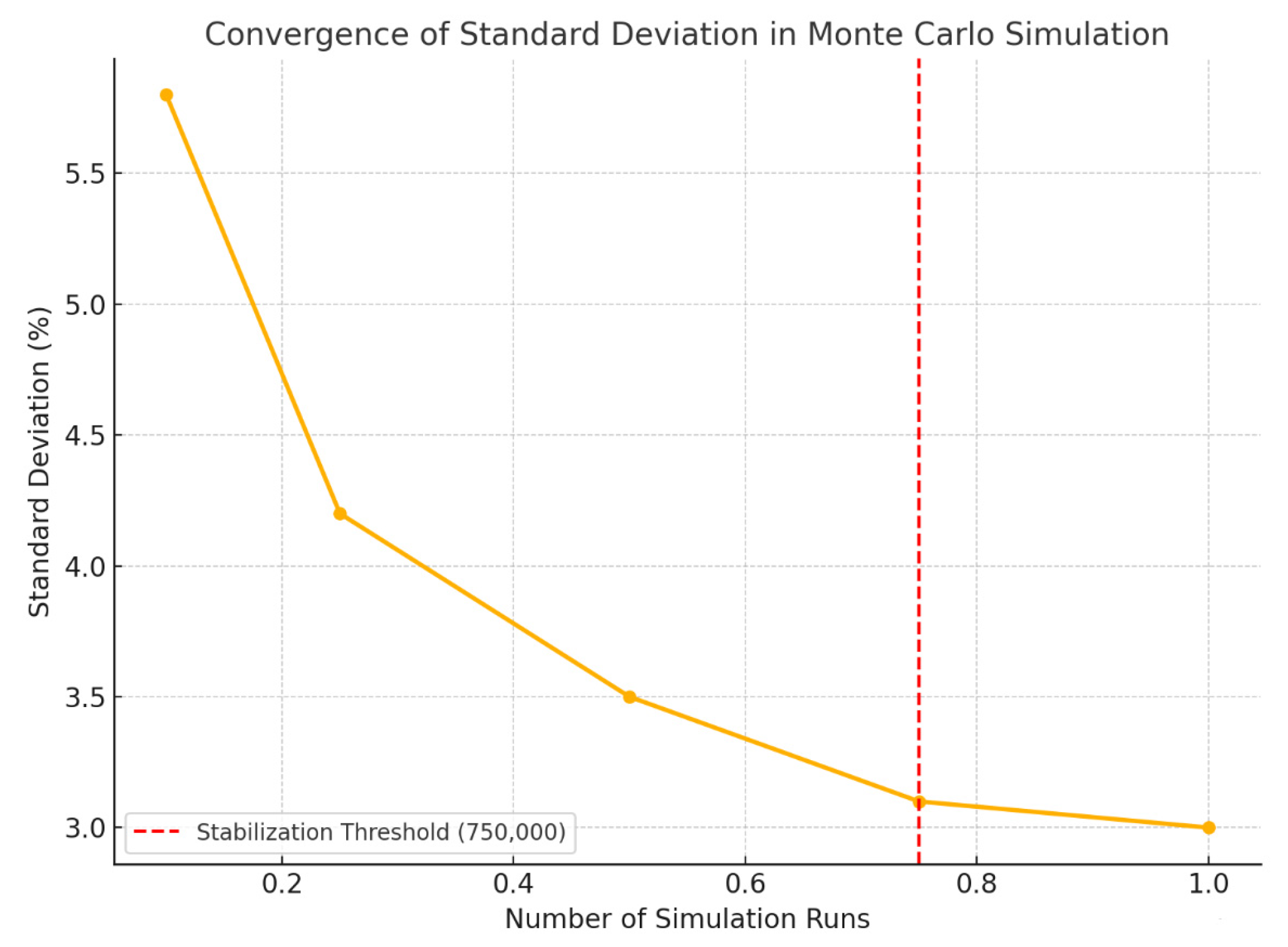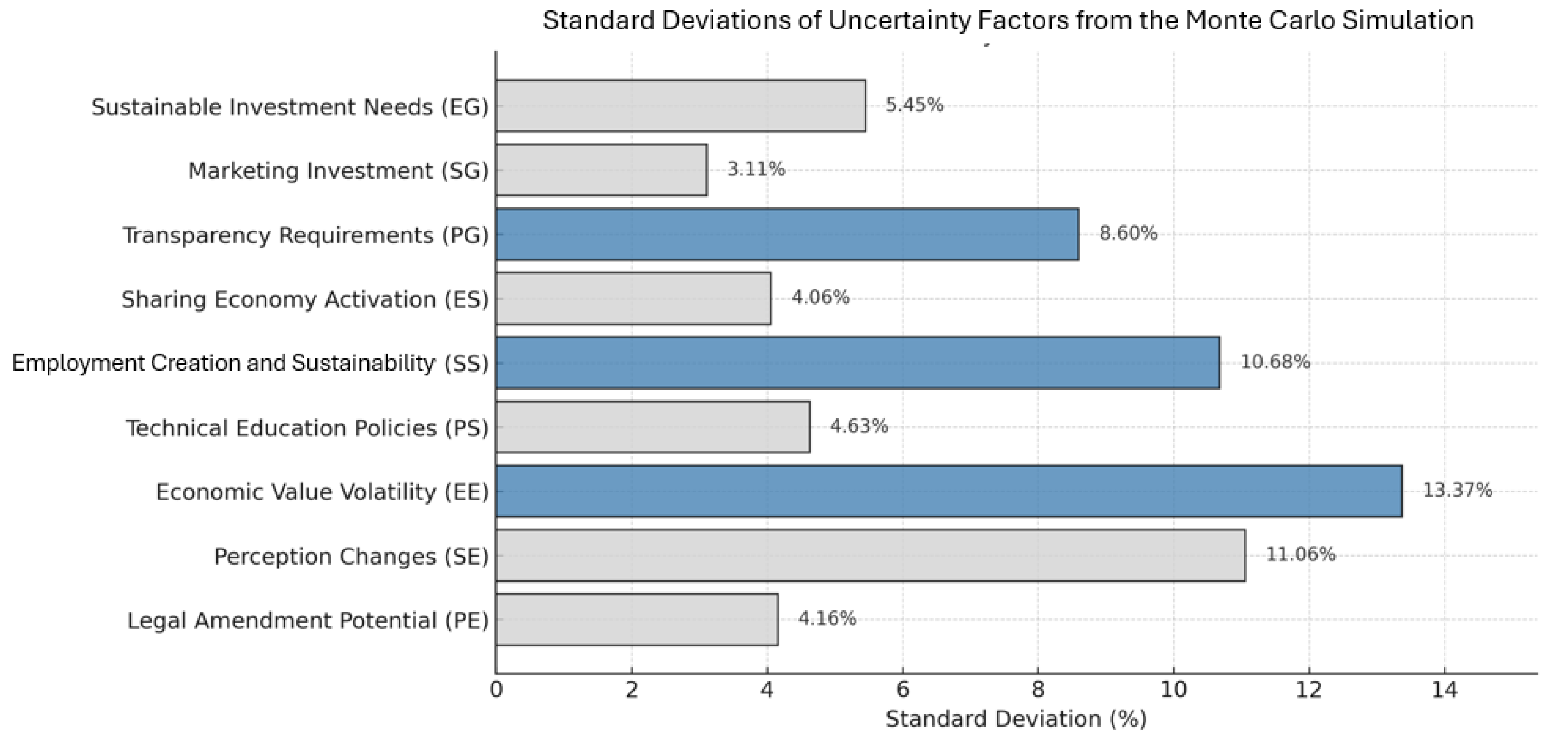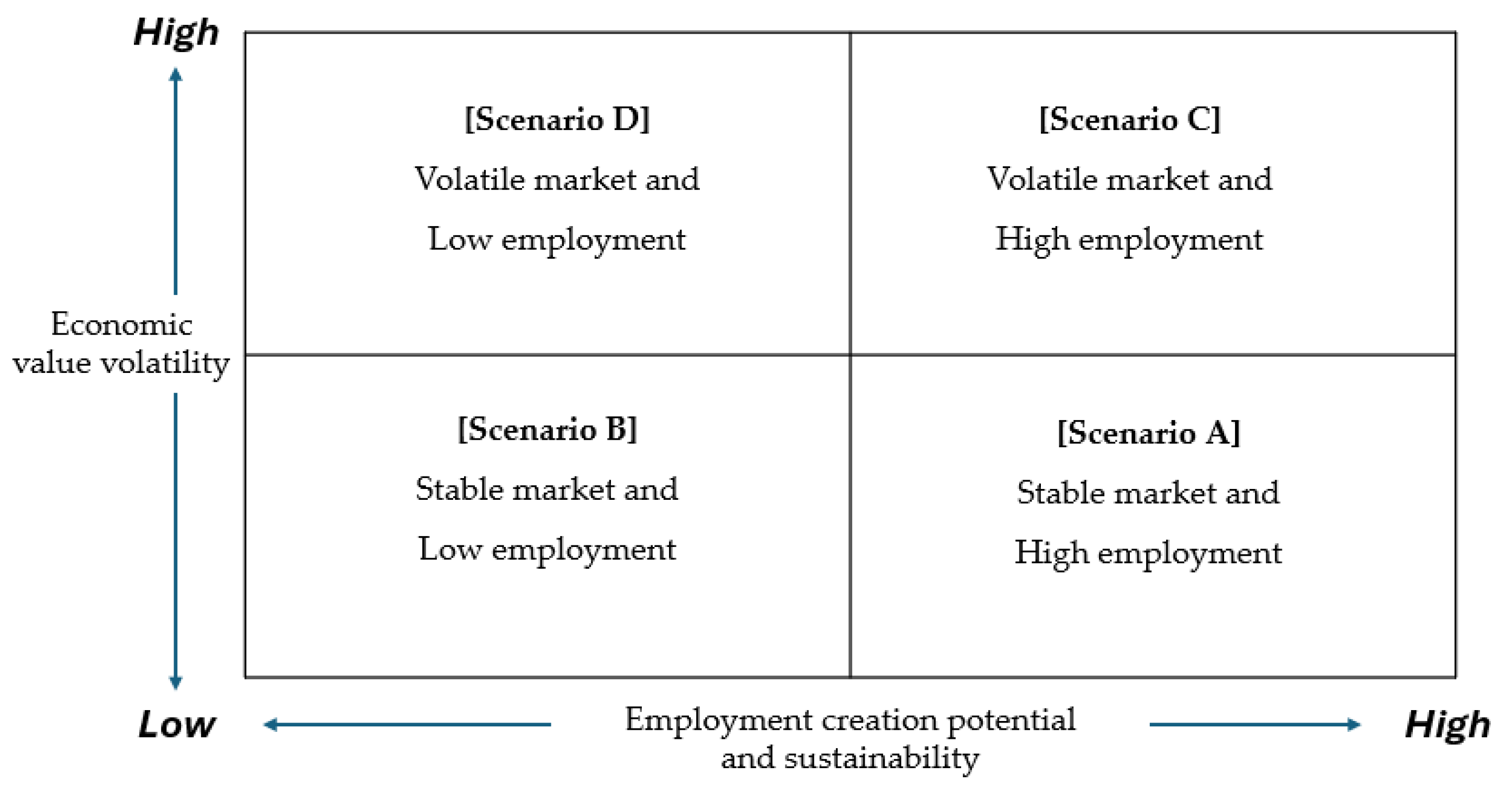1. Introduction
Major countries, including Korea, aim to enhance their energy supply efficiency and achieve significant greenhouse gas reductions by 2050 [
1]. Many nations are expanding renewable energy to meet carbon neutrality targets, yet intermittency remains a challenge for power supply stability [
2]. In response, virtual power plants (VPPs)—which integrate and manage distributed energy resources (DERs)— have emerged as a critical technology for addressing the intermittency of renewable energy [
3,
4]. Although demand response (DR)-based VPPs are currently deployed in some industrial sectors [
5], resource availability has declined amid industrial restructuring and economic uncertainty. Consequently, electric vehicle (EV) batteries, enabled by vehicle-to-grid (V2G) technology, are gaining attention as alternative VPP assets to complement fluctuating renewables and improve grid stability [
6].
Many countries are advancing EV battery integration into VPPs [
7]. The United States (via FERC Order No. 2222) and the European Union (“Clean Energy for All Europeans”) have established frameworks that encourage small-scale DER participation, thus laying the groundwork for EV-based VPP operations. In contrast, other nations (e.g., Korea) remain in earlier stages, requiring policy and institutional development. Given the increasing complexity of energy transitions and sustainability challenges, traditional market-driven decision-making focused primarily on short-term cost-effectiveness is no longer sufficient. Instead, environmental, social, and governance (ESG) considerations must be prioritized because they directly influence public acceptance, regulatory compliance, and the equitable distribution of benefits, all of which are essential for the long-term viability and resilience of EV battery-based VPP operations [
8]. In particular, governance factors such as transparency and social factors including public acceptance are critical in ensuring community support and mitigating potential conflicts or societal backlash associated with new technologies [
9].
Nevertheless, existing studies still focus on the technical feasibility and short-term efficiency (e.g., real-time scheduling, DR programs), overlooking broader and longer-term factors such as policy uncertainties, social acceptance, and the role of transparency in shaping public trust. This highlights the necessity for an integrated analytical framework that explicitly incorporates ESG factors, ensuring that EV–VPP integration strategies are robust under various long-term uncertainty scenarios.
Accordingly, this study assumes that EV batteries can serve as VPP resources for both grid stability and carbon neutrality [
10], and seeks to systematically identify the uncertainties in EV–VPP integration from an ESG perspective. We propose future scenarios and response strategies by applying a mixed-methods approach combining scenario planning, Monte Carlo simulations, and scenario matrices [
11,
12]. This design captures key ESG elements (economic feasibility, social acceptance, transparency requirements) and derives practical insights for EV battery and VPP policies and industrial strategies, ultimately contributing to an ESG-focused sustainable energy transition. The remainder of this paper is organized as follows:
Section 2 reviews the relevant literature and identifies research gaps.
Section 3 presents the research design and methodology in detail.
Section 4 reports the simulation results, while
Section 5 discusses the interpretation of the derived scenarios and their strategic implications from an ESG perspective. Finally,
Section 6 concludes the study and offers suggestions for future research.
4. Results
To maintain readability, only the main results are highlighted here; detailed statistical outputs and sensitivity values are included in the
Appendix A.
4.1. Stage 1: Result of the Framework Design
A 3 × 3 matrix was constructed by mapping ESG dimensions (horizontal axis) against PEST factors (vertical axis), resulting in nine combined categories: PE, SE, EE, PS, SS, ES, PG, SG, and EG. Notably, political and technological factors were merged due to their strong interdependence in the energy sector, where policy drives innovation and vice versa [
68]. This classification scheme provided a structured basis for categorizing the initial uncertainty factors and ensuring alignment with both sustainability and macro-environmental perspectives.
4.2. Stage 2: Results of the Initial Identification of Uncertainty Factors
As listed in
Table 1, 46 uncertainty factors were identified through semi-structured interviews with the optimal expert group. Key uncertainty factors include the possibility of legal and regulatory changes (PE), government subsidies and taxation policies (EE), community acceptance (PS), fluctuations in raw material prices (EE), integration with renewable energy (PE), transparency and standardization requirements (PG), and changes in ESG investment indicators (EG). These factors are interdependent, suggesting that changes in one area may have cascading effects on other areas. Additionally, the linkage between decentralized power and renewable energy policies, growth potential in the battery recycling and reprocessing market (EE), and community participation and conflict resolution (PS) create positive synergies between VPP and EV battery utilization while simultaneously introducing uncertainties owing to policy changes or social conflicts, thereby having dual impacts. The need for enhanced transparency and reliability (SG) and education and talent development (PS) highlights that stakeholder collaboration and social consensus across the entire VPP industry ecosystem must be considered in future development.
4.3. Stage 3: Results of the Selection of the Primary Uncertainty Factors
Among the initially derived 46 uncertainty factors, 27 factors were selected based on their perceived “significant external influence”, as shown in
Table 2. (See
Appendix A Table A5 for the detailed contents).
Through expert re-evaluation, this stage prioritized uncertainty factors with the greatest potential for systemic impact across PEST-ESG domains. Experts identified four key drivers: policy volatility, economic uncertainty, social acceptance, and governance transparency. In the policy domain, legal revisions, subsidy policies, and alignment emerged as critical, while social acceptance hinged on perception changes and job creation. Economic value volatility was ranked highest across categories, with attention to emerging business models and the sharing economy. Governance-related factors, particularly procedural clarity and trust in subsidy and recycling systems, were also emphasized. These findings highlight the cross-cutting nature of uncertainty, underscoring both risks and opportunities for future EV–VPP deployment.
4.4. Stage 4: Results of the Selection of Secondary Uncertainty Factors
As shown in
Table 3, nine secondary uncertainty factors were selected from 27 candidates based on their ESG relevance. “Legal amendment potential” (PE) received the highest score, and selections were made within each domain to ensure balanced ESG representation. This stage emphasized sustainability by reaffirming the importance of legal and economic volatility, while also elevating social and governance priorities such as “Employment creation potential and sustainability” (SS), “Technical education and workforce development policies” (PS), and “Increased transparency requirements” (PG). High scores for “Sustained marketing investment” (SG) and “Activation of the sharing economy and potential for business model innovation” (ES) reflect growing interest in long-term value creation. Overall, the results highlight that social and governance factors are not secondary, but central to building resilient EV–VPP strategies.
4.5. Stage 5: Results of the Final Selection of Uncertainty Factors
To address the first research question “What are the critical uncertainties surrounding EV battery utilization in VPPs from an ESG perspective?” this section presents the final selection of uncertainty drivers derived from the Monte Carlo simulation. The analysis confirms the dominant influence of economic value volatility, employment creation potential, and transparency requirements, each representing one of the ESG pillars. To enhance the robustness of the nine previously identified uncertainty factors, a probabilistic analysis was conducted using Monte Carlo simulation. This process involved defining input variables, assigning appropriate probability distributions, and executing high-volume simulations. The outcomes enabled the identification of three high-impact uncertainty drivers, which formed the foundation of the 2 × 2 scenario matrix developed in the following section. Detailed procedures and simulation results are provided in the subsequent subsections.
4.5.1. Steps 1 and 2: Results of Variable Selection and the Extraction of Probability Distribution Parameters
As illustrated in
Table 4, a total of fifty-one variables were initially identified across nine uncertainty factors, with each factor comprising four to seven variables. To enhance model clarity and avoid excessive complexity, an additional expert consensus process was conducted. Through this, each uncertainty factor was distilled to three core variables, resulting in a final set of twenty-seven variables. These variables maintained the conceptual breadth of the initial pool, encompassing key thematic domains such as policy alignment, technological volatility, market uncertainty, social acceptance, investment sustainability, and regulatory transparency. Of particular note, employment-related variables were refined to emphasize sustainable job creation and broader social benefits rather than short-term labor fluctuations, reinforcing alignment with ESG principles.
As shown in
Table 5, parameter values for each variable, such as the minimum, most likely, and maximum estimates were derived through a structured Consensus Conference [
69]. This process incorporated expert-informed perspectives on policy foresight, societal trends, market competitiveness, and governance robustness, reflecting both the present conditions and anticipated future uncertainties [
70]. Monte Carlo simulations were then conducted to model various scenario pathways, including early or delayed regulatory amendments and divergent trajectories of technological innovation. A range of probability distributions, binomial, normal, triangular, Poisson, discrete, and lognormal, was applied to match the unique characteristics of each uncertainty factor. For instance, binomial distributions were used for binary events (e.g., regulatory enactment), while normal and triangular distributions were employed for continuous variables such as the legal amendment intensity, timing, and investment efficiency. These refinements supported intuitive, probabilistically grounded scenario development and enabled a more robust evaluation of ESG-related risks and opportunities in EV–VPP integration.
4.5.2. Steps 3 and 4: Results of Simulation Execution and the Final Selection of Uncertainties
The Python code used to execute the Monte Carlo simulations underpinning the visualizations in
Figure 4 and quantitative outcomes in
Figure 5 is available in a public repository (see
Appendix B for the access link). For the detailed quantitative outputs shown in
Figure 5, please refer to
Appendix A Table A9.
To identify the most critical uncertainty drivers, we analyzed the standard deviations of projected market growth from the Monte Carlo simulation. As shown in
Figure 5, three factors with the highest variability were selected as final scenario drivers:
Economic value volatility (EE)—13.37%;
Employment creation potential and sustainability (SS)—10.68%;
Increased transparency requirements (PG)—8.60%.
Although perception change (SE) showed a higher deviation (11.06%) than some selected factors, it was excluded based on the study’s principle of selecting one variable per ESG domain. Its relevance, however, was considered during scenario interpretation. These findings confirm that the selected variables are not only statistically significant but also highly sensitive to external conditions [
71], with clear interdependencies—e.g., rising economic volatility may reduce employment or governance trust. This highlights the importance of an integrated ESG perspective in addressing systemic uncertainty in EV–VPP systems. In summary, high-variance ESG drivers offer both analytical clarity and strategic value in guiding resilient policies and investments for sustainable VPP development.
Table 6 presents the results of the sensitivity analysis executed using a Python-based model. (See
Appendix A Table A10 for the detailed contents.)
This section presents the results of the sensitivity analysis conducted to evaluate the robustness of the Monte Carlo simulation model. As shown in
Table 6, each of the 27 input variables was individually adjusted within a ±10% range from its baseline value to examine the extent to which minor deviations affect the projected market growth rate. The resulting changes in standard deviations were found to remain within a 1% margin across all variables, indicating that the model is highly stable under moderate parameter fluctuations. Such consistency demonstrates that the simulation outcomes are not significantly affected by slight variations in input assumptions, thereby validating the model’s reliability for long-term scenario-based forecasting. This result enhances confidence in the model’s suitability for analyzing ESG-related uncertainties in the context of EV battery integration into virtual power plants (VPPs). To generate these results, a Python-based simulation framework was developed by extending the core code presented in the
Appendix B. The automated structure of this framework enables repeated sensitivity testing with minimal user intervention, facilitating efficient model calibration and validation. Researchers and practitioners can utilize this approach to iteratively test a wide range of scenarios and improve the interpretability of simulation-based energy policy planning [
72,
73].
4.6. Stage 6: Results of the 2 × 2 Scenario Matrix
To construct a 2 × 2 scenario matrix, we selected economic value volatility (EE, 13.37%), employment creation potential and sustainability (SS, 10.68%), and increased transparency requirements (PG, 8.60%) as the final uncertainty factors based on their standard deviations obtained from the Monte Carlo simulation. The two factors with the highest standard deviations—employment creation potential and sustainability (X-axis) and economic value volatility (Y-axis)—were designated as the principal axes, whereas increased transparency requirements were set as a subsidiary factor.
Figure 6 presents a 2 × 2 scenario matrix constructed with employment creation potential and sustainability on the
X-axis and economic value volatility on the
Y-axis, with increased transparency requirements as a subsidiary factor. The following four scenarios were derived from this matrix and detailed interpretations and strategic responses to each scenario are discussed in
Section 5:
Scenario A—This ideal scenario envisions continuous industrial growth facilitated by stable policy support and corporate investment. This occurs when proactive government policies align with long-term corporate investment commitments.
Scenario B—In this scenario, while the industrial environment remains stable, advancements in technology and automation limit employment opportunities. This highlights the impact of automation and innovation on employment within the existing industrial framework.
Scenario C—Characterized by high market volatility, this scenario perceives active job creation driven by technological innovation and the emergence of new business models, indicating that uncertain market conditions can foster new opportunities.
Scenario D—This scenario depicts a situation in which rapid industrial changes, coupled with a focus on automation and efficiency, adversely affect the labor market, emphasizing the negative impact of automation on employment amid high volatility.
5. Discussion
The scenarios presented in this study are not speculative narratives but are grounded in statistically significant uncertainty drivers. Final scenario axes were selected based on the highest standard deviations derived from 1,000,000 Monte Carlo simulation runs, ensuring interpretability and traceability across empirical outcomes. Building upon the 2 × 2 scenario matrix presented in
Figure 6, this section offers a detailed interpretation of each of the four scenarios and derives practical implications for policymakers and industry stakeholders. The analysis focuses on how the interplay of
economic value volatility,
employment creation potential, and
ESG transparency requirements shapes the future trajectories of the EV battery and VPP industries.
In Scenario A, the EV battery and VPP industries sustained stable growth, driven by the increasing demand for electric vehicles and the global transition to sustainable energy. This scenario assumes that strong policy support and long-term corporate investment create a solid foundation for industrial expansion [
74]. Consequently, there is a growing demand for highly skilled workers in battery recycling, operation, and data analytics, reflecting a qualitative improvement in employment opportunities rather than simply quantitative growth [
75]. This shift contributes to positive social spillover effects as industries benefit from a well-trained workforce. Furthermore, high ESG transparency requirements encourage companies to systematically disclose ESG data, thus fostering long-term corporate value growth and trust building [
76]. Given this stable environment, policymakers could further incentivize infrastructure development and R&D through targeted financing or green bond issuance, ensuring continuous industry growth [
77,
78]. Meanwhile, private enterprises can capitalize on the favorable market by investing in workforce training and retention programs that align with emerging technologies and ESG principles. By doing so, they strengthen their position against future disruptions and maintain public trust. Finally, strengthening ESG disclosure frameworks and establishing regular stakeholder communication channels are crucial to secure long-term trust [
79].
In Scenario B, the EV battery and VPP industries maintain stable economic value; however, automation- and efficiency-driven strategies limit new job creation [
80]. Although firms operate in a stable market environment, they prioritize cost reduction and productivity enhancement through advanced technology and automation, leading to restrained hiring beyond essential personnel. Even under high transparency requirements, employment growth remains limited, as companies may focus on enhancing environmental sustainability and governance structures to maintain public trust [
81]. Given this scenario, companies must maximize cost efficiency through automation, AI, and big data analytics, while selectively hiring a small number of highly skilled specialists [
82]. At the same time, governments might focus on upskilling and reskilling the existing workforce by providing targeted educational programs that support high-tech automation skills, and firms should weigh the benefits of automation against the potential reputational risks associated with minimal job creation. By actively communicating their ESG efforts—particularly around environmental stewardship and social contributions—companies can mitigate negative perceptions and maintain stakeholder confidence. Governments and educational institutions should work together to enhance workforce training programs, and firms should actively promote ESG initiatives to demonstrate their commitment to sustainability and ethical management.
Scenario C is characterized by high economic value volatility, leading to rapid market expansion and a surge in employment creation. Although this volatility can generate significant short-term profits, the sustainability of these employment opportunities remains uncertain. Companies may adopt flexible workforce strategies, including project-based contracts and partnerships, to manage this uncertainty [
83]. Given the high transparency requirements, firms must be prepared to address the environmental risks and community concerns that may arise during periods of rapid market growth.
Under these conditions, policymakers could implement adaptive regulations and contingency funds to stabilize the market when volatility spikes, minimizing potential negative spillovers. Companies should invest in diversified portfolios spanning energy storage systems, renewables, and VPP solutions to hedge against sudden market downturns. Moreover, engaging in transparent ESG reporting and proactive stakeholder dialogue can help firms maintain credibility even when expansion proceeds at a breakneck pace. To navigate this high-risk, high-reward environment, firms should diversify their energy sector investments, including energy storage systems, renewable energy, and VPP technologies, to hedge against volatility. They should also implement flexible hiring structures, allowing them to quickly scale up or down as needed. Additionally, regular ESG disclosures and transparent risk management processes are essential for maintaining trust among stakeholders.
Scenario D represents a highly volatile economic environment with intense technological competition that severely limits new employment creation. Under these conditions, companies focus on cost reduction and efficiency by prioritizing process automation and AI-driven optimization over new hiring [
84]. Instead of expanding their workforce, firms reallocate existing employees and invest in technological advancements. Simultaneously, strict ESG transparency requirements force companies to disclose financial and ESG performance data regularly, compelling them to adopt alternative corporate social responsibility initiatives, such as environmental protection and community engagement, to maintain a positive reputation.
Policymakers in this scenario might need to offer incentives for collaborative R&D among firms, aiming to mitigate the risks of excessive technological competition and ensure that smaller players are not entirely excluded. For businesses, rigorous risk management systems and AI-driven optimization become critical to remaining competitive, but they should also communicate how these efficiency gains contribute to broader environmental or social goals. To withstand extreme market fluctuations, firms must establish rigorous risk management and internal control systems to maintain investor confidence [
85]. Moreover, maximizing the use of AI and automation is essential to ensure cost efficiency and competitiveness. Because new employment creation is minimal, firms should focus on enhancing environmental performance and social contribution initiatives to strengthen their corporate image and secure long-term competitiveness.
Unlike previous studies that primarily focused on short-term technological optimization, this study adopted a comprehensive scenario analysis approach that integrates long-term sustainability, social acceptance, policy support, and ESG transparency requirements. By defining economic value volatility and employment creation potential as core uncertainties and incorporating ESG transparency requirements as a secondary factor, this study presents a more holistic perspective on the long-term development pathways of the EV battery and VPP industries beyond purely technological considerations. In particular, the scenario narratives are not abstract descriptions but are directly derived from simulation results based on empirical distributions. The key uncertainties were selected using statistical metrics, namely, standard deviation values extracted from 1,000,000 Monte Carlo simulation runs. These quantified outcomes enabled the construction of a scenario matrix grounded in interpretable numerical patterns, addressing concerns that scenario planning alone may yield overly speculative or vague conclusions. The strategic insights and policy recommendations outlined in each scenario thus provide tangible guidance for government agencies and industry leaders seeking to navigate diverse future conditions, whether stable or volatile, and to align technology investments with ESG priorities.
Furthermore, the scenario-based methodology proposed in this study holds significant potential for supporting national-scale grid stability initiatives. As countries advance their energy transition policies, the integration of electric vehicle (EV) batteries as distributed energy resources within virtual power plants (VPPs) can enhance frequency regulation, demand response, and overall system reliability. Recent studies have demonstrated the technical feasibility of large-scale, bi-directional EV fleet control for ancillary service provision, showing that real-time coordination of EV charging and discharging can effectively contribute to frequency containment and grid balancing using empirical fleet data [
86]. Extending the proposed methodology to national-scale simulations would allow policymakers to more accurately anticipate system-level uncertainties and to design resilient energy infrastructures aligned with environmental, social, and governance (ESG) objectives.
6. Conclusions
The findings of this study demonstrate that each scenario provides a multifaceted outlook on market growth potential and employment creation, emphasizing not only technological optimization but also the comprehensive impacts of policy and societal factors on industry development. By highlighting social responsibility and sustainability, which have often been overlooked in previous research, this study clarifies how employment creation and ESG requirements interact under various conditions. Consequently, this study offers strategic directions for businesses and policymakers to navigate evolving market environments effectively.
The academic contribution of this study lies in its broader perspective on the future trajectory of the EV battery and VPP industries. By incorporating social and policy dimensions into a scenario-based framework, it advances long-term industry forecasting beyond the scope of traditional techno-economic analyses. Specifically, the focus on economic value and employment creation potential—paired with ESG transparency—enables a more comprehensive understanding of systemic transitions. From a policy and industry standpoint, this study provides actionable insights into transparency-enhancing governance and workforce development programs. Building on these insights, this study further proposes a decentralized VPP structure that enables the aggregation and coordination of distributed EV-based energy storage systems. This structure leverages digital platforms and intermediary aggregators to manage bidirectional energy flows, facilitate participation in demand response programs, and uphold ESG principles such as fairness, data transparency, and community benefit. These findings serve as practical guidance for stakeholders seeking to align technology investments with sustainability and social value creation.
Furthermore, this study employed a mixed-methods approach that combines scenario planning with Monte Carlo simulations, thereby supplementing traditional qualitative analyses with quantitative uncertainty assessments. By using scenario planning to explore various future pathways and Monte Carlo simulations to provide probabilistic analyses of each pathway, this study produced more reliable and realistic policy recommendations. This hybrid methodology is particularly effective for systematically analyzing uncertainties in complex systems, making it a valuable contribution to future applications across diverse industries. Despite its contributions, this study had several limitations. First, it does not fully incorporate the impacts of external variables, such as regulatory changes, geopolitical dynamics, and the pace of technological innovation. Future research should expand the scenario analysis by integrating quantitative models and empirical data to account for these external factors. In addition, more empirical case studies should be conducted to enhance the practical applicability of these findings for industry professionals. This study provides a comprehensive perspective on the development of the EV battery and VPP industries, reaffirming the significance of sustainable energy transitions and social value creation from an ESG perspective. The findings offer valuable implications for policy formulation and corporate strategy, and serve as a foundational reference for future refined research in this field.












